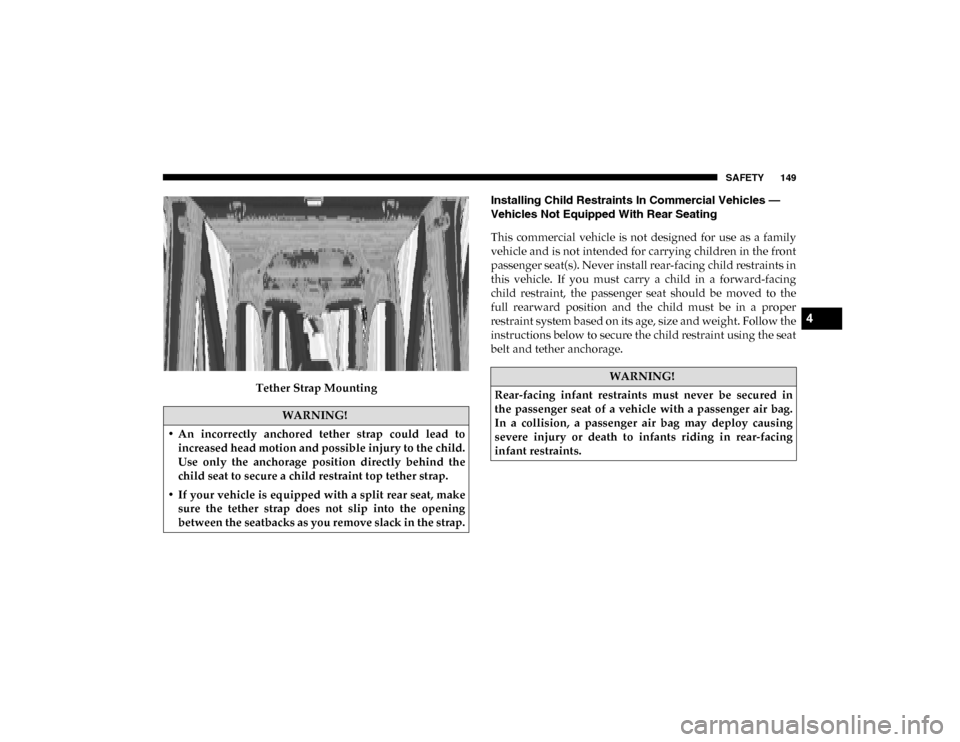2020 Ram ProMaster City weight
[x] Cancel search: weightPage 143 of 350

140 SAFETY
Frequently Asked Questions About Installing Child Restraints With LATCH
What is the weight limit (child’s weight
+ weight of the child restraint) for using
the LATCH anchorage system to attach
the child restraint? 65 lbs (29.5 kg)Use the LATCH anchorage system until
the combined weight of the child and
the child restraint is 65 lbs (29.5 kg). Use
the seat belt and tether anchor instead
of the LATCH system once the
combined weight is more than 65 lbs
(29.5 kg).
Can the LATCH anchorages and the
seat belt be used together to attach a
rear-facing or forward-facing child
restraint? NoDo not use the seat belt when you use
the LATCH anchorage system to attach
a rear-facing or forward-facing child
restraint.
Booster seats may be attached to the
LATCH anchorages if allowed by the
booster seat manufacturer. See your
booster seat owner’s manual for more
information.
Can a child seat be installed in the
center position using the inner LATCH
lower anchorages from the outboard
seating positions? No
Use the seat belt and tether anchor to
install a child seat in the center seating
position.
2020_RAM_PROMASTER_CITY_OM_USA=GUID-7B6A7FCA-79B0-423F-95C5-ED2A949C3D13=1=en=.book Page 140
Page 149 of 350

146 SAFETY
Frequently Asked Questions About Installing Child Restraints With Seat Belts
What is the weight limit (child’s weight
+ weight of the child restraint) for using
the Tether Anchor with the seat belt to
attach a forward facing child restraint? Weight limit of the Child RestraintAlways use the tether anchor when
using the seat belt to install a forward
facing child restraint, up to the
recommended weight limit of the
child restraint.
Can the rear-facing child restraint touch
the back of the front passenger seat? YesContact between the front passenger
seat and the child restraint is allowed,
if the child restraint manufacturer
also allows contact.
Can the rear head restraints be
removed? YesThe 2nd row head restraints can be
removed in every seating position if
they interfere with the installation of
the child restraint.
Refer to “Head Restraints” in
“Getting To Know Your Vehicle” for
further information.
Can the buckle stalk be twisted to
tighten the seat belt against the belt path
of the child restraint? NoDo not twist the buckle stalk in a
seating position with an ALR
retractor.
2020_RAM_PROMASTER_CITY_OM_USA=GUID-7B6A7FCA-79B0-423F-95C5-ED2A949C3D13=1=en=.book Page 146
Page 152 of 350

SAFETY 149
Tether Strap MountingInstalling Child Restraints In Commercial Vehicles —
Vehicles Not Equipped With Rear Seating
This commercial vehicle is not designed for use as a family
vehicle and is not intended for carrying children in the front
passenger seat(s). Never install rear-facing child restraints in
this vehicle. If you must carry a child in a forward-facing
child restraint, the passenger seat should be moved to the
full rearward position and the child must be in a proper
restraint system based on its age, size and weight. Follow the
instructions below to secure the child restraint using the seat
belt and tether anchorage.
WARNING!
• An incorrectly anchored tether strap could lead to increased head motion and possible injury to the child.
Use only the anchorage position directly behind the
child seat to secure a child restraint top tether strap.
• If your vehicle is equipped with a split rear seat, make sure the tether strap does not slip into the opening
between the seatbacks as you remove slack in the strap.
WARNING!
Rear-facing infant restraints must never be secured in
the passenger seat of a vehicle with a passenger air bag.
In a collision, a passenger air bag may deploy causing
severe injury or death to infants riding in rear-facing
infant restraints.
4
2020_RAM_PROMASTER_CITY_OM_USA=GUID-7B6A7FCA-79B0-423F-95C5-ED2A949C3D13=1=en=.book Page 149
Page 185 of 350

182 STARTING AND OPERATING
NOTE:
• Tighten the fuel filler cap until you hear a “clicking”sound. This is an indication that the fuel filler cap is prop -
erly tightened.
• If the gas cap is not tightened properly, the MIL may come on. Be sure the gas cap is tightened every time the vehicle
is refueled.
VEHICLE LOADING
As required by National Highway Traffic Safety Administra -
tion regulations, your vehicle has a certification label affixed
to the driver's side door or B-Pillar.
If seats are removed for carrying cargo, do not exceed the
specified GVWR and GAWR.
Vehicle Certification Label
Your vehicle has a Vehicle Certification Label affixed to the
drivers side B-Pillar or the rear of the driver’s door.
The label contains the following information:
• Name of manufacturer
• Month and year of manufacture
• Gross Vehicle Weight Rating (GVWR)
• Gross Axle Weight Rating (GAWR) front
• Gross Axle Weight Rating (GAWR) rear
• Vehicle Identification Number (VIN)
• Type of vehicle
• Month, Day, and Hour of manufacture (MDH)
The bar code allows a computer scanner to read the VIN.
• A fire may result if gasoline is pumped into a portable
container that is inside of a vehicle. You could be
burned. Always place gas containers on the ground
while filling.
CAUTION!
• Damage to the fuel system or emissions control system could result from using an improper fuel tank filler
tube cap. A poorly fitting cap could let impurities into
the fuel system and may cause the “Malfunction Indi -
cator Light (MIL)” to turn on, due to fuel vapors
escaping from the system.
• To avoid fuel spillage and overfilling, do not “top off” the fuel tank after filling.
WARNING! (Continued)
2020_RAM_PROMASTER_CITY_OM_USA=GUID-7B6A7FCA-79B0-423F-95C5-ED2A949C3D13=1=en=.book Page 182
Page 186 of 350

STARTING AND OPERATING 183
Gross Vehicle Weight Rating (GVWR)
The GVWR is the total allowable weight of your vehicle. This
includes driver, passengers, and cargo. The total load must
be limited so that you do not exceed the GVWR.
Gross Axle Weight Rating (GAWR)
The GAWR is the maximum capacity of the front and rear
axles. Distribute the load over the front and rear axles evenly.
Make sure that you do not exceed either front or rear GAWR.
Tire Size
The tire size on the Vehicle Certification Label represents the
actual tire size on your vehicle. Replacement tires must be
equal to the load capacity of this tire size.
Rim Size
This is the rim size that is appropriate for the tire size listed.
Inflation Pressure
This is the cold tire inflation pressure for your vehicle for all
loading conditions up to full GAWR.
Curb Weight
The curb weight of a vehicle is defined as the total weight of
the vehicle with all fluids, including vehicle fuel, at full
capacity conditions, and with no occupants or cargo loaded
into the vehicle. The front and rear curb weight values are
determined by weighing your vehicle on a commercial scale
before any occupants or cargo are added.
Overloading
The load carrying components (axle, springs, tires, wheels,
etc.) of your vehicle will provide satisfactory service as long
as you do not exceed the GVWR and the front and rear
GAWR.
The best way to figure out the total weight of your vehicle is
to weigh it when it is fully loaded and ready for operation.
Weigh it on a commercial scale to ensure that it is not over
the GVWR.
WARNING!
Because the front wheels steer the vehicle, it is important
that you do not exceed the maximum front or rear
GAWR. A dangerous driving condition can result if
either rating is exceeded. You could lose control of the
vehicle and have a collision.5
2020_RAM_PROMASTER_CITY_OM_USA=GUID-7B6A7FCA-79B0-423F-95C5-ED2A949C3D13=1=en=.book Page 183
Page 187 of 350

184 STARTING AND OPERATING
Figure out the weight on the front and rear of the vehicle
separately. It is important that you distribute the load evenly
over the front and rear axles.
Overloading can cause potential safety hazards and shorten
useful service life. Heavier axles or suspension components
do not necessarily increase the vehicle's GVWR.
Loading
To load your vehicle properly, first figure out its empty
weight, axle-by-axle and side-by-side. Store heavier items
down low and be sure you distribute their weight as evenly
as possible. Stow all loose items securely before driving. If
weighing the loaded vehicle shows that you have exceeded
either GAWR, but the total load is within the specified
GVWR, you must redistribute the weight. Improper weight
distribution can have an adverse effect on the way your
vehicle steers and handles and the way the brakes operate.
NOTE:
Refer to the “Vehicle Certification Label” affixed to the
B-Pillar or the rear of the driver's door for your vehicle's
GVWR and GAWRs.
TRAILER TOWING
In this section you will find safety tips and information on
limits to the type of towing you can reasonably do with your
vehicle. Before towing a trailer, carefully review this infor-
mation to tow your load as efficiently and safely as possible.
To maintain the New Vehicle Limited Warranty coverage,
follow the requirements and recommendations in this
manual concerning vehicles used for trailer towing.
Common Towing Definitions
The following trailer towing related definitions will assist
you in understanding the following information:
Gross Vehicle Weight Rating (GVWR)
The GVWR is the total allowable weight of your vehicle. This
includes driver, passengers, cargo and tongue weight. The
total load must be limited so that you do not exceed the
GVWR. Refer to “Vehicle Loading/Vehicle Certification
Label” in this chapter for further information.
2020_RAM_PROMASTER_CITY_OM_USA=GUID-7B6A7FCA-79B0-423F-95C5-ED2A949C3D13=1=en=.book Page 184
Page 188 of 350

STARTING AND OPERATING 185
Gross Combination Weight Rating (GCWR)
The GCWR is the total allowable weight of your vehicle and
trailer when weighed in combination.
Gross Trailer Weight (GTW)
The GTW is the weight of the trailer plus the weight of all
cargo, consumables and equipment (permanent or tempo-
rary) loaded in or on the trailer in its "loaded and ready for
operation" condition.
The recommended way to measure GTW is to put your fully
loaded trailer on a vehicle scale. The entire weight of the
trailer must be supported by the scale.
Gross Axle Weight Rating (GAWR)
The GAWR is the maximum capacity of the front and rear
axles. Distribute the load over the front and rear axles evenly.
Make sure that you do not exceed either front or rear GAWR.
Refer to “Vehicle Loading/Vehicle Certification Label” in
this chapter for further information. Tongue Weight (TW)
The tongue weight is the downward force exerted on the
hitch ball by the trailer. You must consider this as part of the
load on your vehicle.
Trailer Frontal Area
The frontal area is the maximum height multiplied by the
maximum width of the front of a trailer.
Trailer Sway Control
The Trailer Sway Control can be a mechanical telescoping
link that can be installed between the hitch receiver and the
trailer tongue that typically provides adjustable friction asso
-
ciated with the telescoping motion to dampen any unwanted
trailer swaying motions while traveling.WARNING!
It is important that you do not exceed the maximum front
or rear GAWR. A dangerous driving condition can result
if either rating is exceeded. You could lose control of the
vehicle and have a collision.
5
2020_RAM_PROMASTER_CITY_OM_USA=GUID-7B6A7FCA-79B0-423F-95C5-ED2A949C3D13=1=en=.book Page 185
Page 189 of 350

186 STARTING AND OPERATING
If equipped, the electronic Trailer Sway Control (TSC) recog-
nizes a swaying trailer and automatically applies individual
wheel brakes and/or reduces engine power to attempt to
eliminate the trailer sway.
Weight-Carrying Hitch
A weight-carrying hitch supports the trailer tongue weight,
just as if it were luggage located at a hitch ball or some other
connecting point of the vehicle. These kinds of hitches are the
most popular on the market today and they are commonly
used to tow small and medium sized trailers.
Weight-Distributing Hitch
The weight-distributing hitch works by applying leverage
through spring (load) bars. They are typically used for
heavier loads to distribute trailer tongue weight to the tow
vehicle's front axle and the trailer axle(s). When used in
accordance with the manufacturer's directions, it provides
for a more level ride, offering more consistent steering and
brake control thereby enhancing towing safety. The addition
of a friction/hydraulic sway control also dampens sway caused by traffic and crosswinds and contributes positively
to tow vehicle and trailer stability. Trailer sway control and
a weight distributing (load equalizing) hitch are recom
-
mended for heavier Tongue Weights (TW) and may be
required depending on vehicle and trailer configuration/
loading to comply with Gross Axle Weight Rating (GAWR)
requirements.
WARNING!
• An improperly adjusted Weight Distributing Hitch system may reduce handling, stability, braking perfor -
mance, and could result in a collision.
• Weight Distributing Systems may not be compatible with Surge Brake Couplers. Consult with your hitch
and trailer manufacturer or a reputable Recreational
Vehicle dealer for additional information.
2020_RAM_PROMASTER_CITY_OM_USA=GUID-7B6A7FCA-79B0-423F-95C5-ED2A949C3D13=1=en=.book Page 186